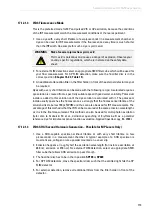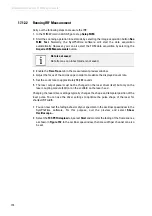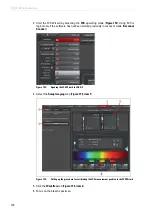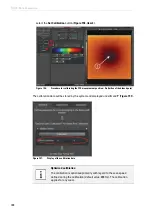
168
Summarized manual for FLIM experiments
17.9
Selecting the Correct Laser Repetition Rate
For pulsed diode lasers from PicoQuant and for the white light laser with pulse picker, the
laser repetition rate can be determined in LAS AF (
). In general, the repetition
rate should be as high as possible to achieve the highest possible photon count rate.
However, the time window after a laser pulse should still be large enough to allow complete
fading of the fluorescence of the excited dye molecules before the next laser pulse.
For example, the duration between two laser pulses at a repetition rate of 80 MHz is 12.5 ns.
If a fluorophore with a lifetime of 6 ns is measured, due to the statistical process, more than
12 % of the photons are emitted after 12.5 ns. In this case, the repetition rate must be
decreased (
). At a laser repetition rate of 80 MHz, the fluorescence does not fade
completely before the end of the time window. Due to a "wrapping effect", the end of the
fading can be observed before the actual laser pulse (
A
). At 40 MHz the time
window is optimally adapted (
B
), while at 20 MHz the fluorescence has already
decayed at less than half of the detection window (
C
). Therefore, 40 MHz would
be the optimal repetition rate in this case.
Upper limit for the count rate
Unnecessarily low photon count rates lead to an extension the data
acquisition, because a certain number of photons is required for the FLIM
analysis. On the other hand, too high of photon count rates can lead to
artifacts and falsify the FLIM analysis due to the pile-up effect. The upper
limit for the count rate is given by:
• TCSPC principle: To prevent pile-up artifacts (pile-up effect:
overestimation of early photons), the identified photon count rate in
general should lie at around 5 % under the laser repetition rate.
When using a laser repetition rate of 20 MHz, this results in a photon
count rate of 1 MHz (1,000 counts/ms). This setting leads to a maximum
underestimation of the fluorescence lifetime of 1 % due to the pile-up
effect.
• TCSPC detector: Some detectors lead to occurrence of artifacts if they
are operated with a high count rate. The APD from type AQR by Perkin
Elmer shows a substantial IRF widening at a photon count rate above
1 MHz and a count rate-dependent IRF movement.
• TCSPC electronics: The acquired photon data are transmitted
continuously via a FIFO buffer from the TCSPC unit (PicoHarp) to the
workstation. If average photon count rates above approx. 3 MHz are
reached (depending on the workstation power), the data acquisition
stops and an error message is displayed:
Summary of Contents for TCS SP8 SMD
Page 1: ...10 Living up to Life User Manual Leica TCS SP8 SMD for FCS FLIM and FLCS ...
Page 4: ...4 Copyright ...
Page 14: ...14 Contents ...
Page 18: ...18 Intended Use ...
Page 20: ...20 Liability and Warranty ...
Page 28: ...28 General Safety Notes ...
Page 32: ...32 Additional Notes on Handling the System ...
Page 44: ...44 System Overview and Properties ...
Page 60: ...60 SMD Components Figure 31 DSN 102 Dual SPAD Power Supply ...
Page 80: ...80 Safety Features ...
Page 102: ...102 Switching On the System ...
Page 116: ...116 LAS AF ...
Page 214: ...214 Changing the Specimen ...
Page 216: ...216 Changing the Objective ...
Page 238: ...238 Switching Off the System ...
Page 242: ...242 Repairs and Service Work ...
Page 244: ...244 Maintenance ...
Page 246: ...246 Disassembly and Transport ...
Page 248: ...248 Disposal ...
Page 254: ...254 Contact ...
Page 256: ...256 Recommended Literature ...
Page 266: ...266 Appendix Figure 225 Declaration of conformity ...
Page 268: ...268 Appendix ...
Page 269: ......






























